Bucha killings: Satellite image of bodies site contradicts Russian claims
- Published

A satellite image of Bucha in Ukraine appears to show bodies lying in the street nearly two weeks before the Russians left the town.
The image from 19 March, first reported by the New York Times and confirmed by the BBC, directly contradicts Russian Foreign Minister Sergei Lavrov's claim that footage of bodies in Bucha, that has emerged in recent days, was "staged" after the Russians withdrew.
The satellite image shows objects that appear to be bodies in the exact locations where they were subsequently found by Ukrainian forces when they regained control of the town north of Kyiv.
Along another section of the road, the image shows what appear to be more bodies on the ground.

There is an earlier satellite image available from Maxar on 11 March. It appears to show bodies in the same locations but is less clear than the one on 19 March.
Russia has made a series of unfounded claims relating to images from Bucha - here's what the evidence tells us.
Warning: This piece contains graphic images which some may find upsetting.
Claim: 'Faked dead bodies'
Russia says its forces withdrew from Bucha on 30 March. The Ukrainians say this happened in the early hours of 31 March.
On 1 April, footage was posted filmed from a car , externaldriving through the town which showed bodies on either side of a road.
Russia has claimed it shows "fake dead bodies" and was "staged" after its troops left the town.
We compared the car footage with the satellite imagery of Bucha from 19 March (when the Russians were in control).
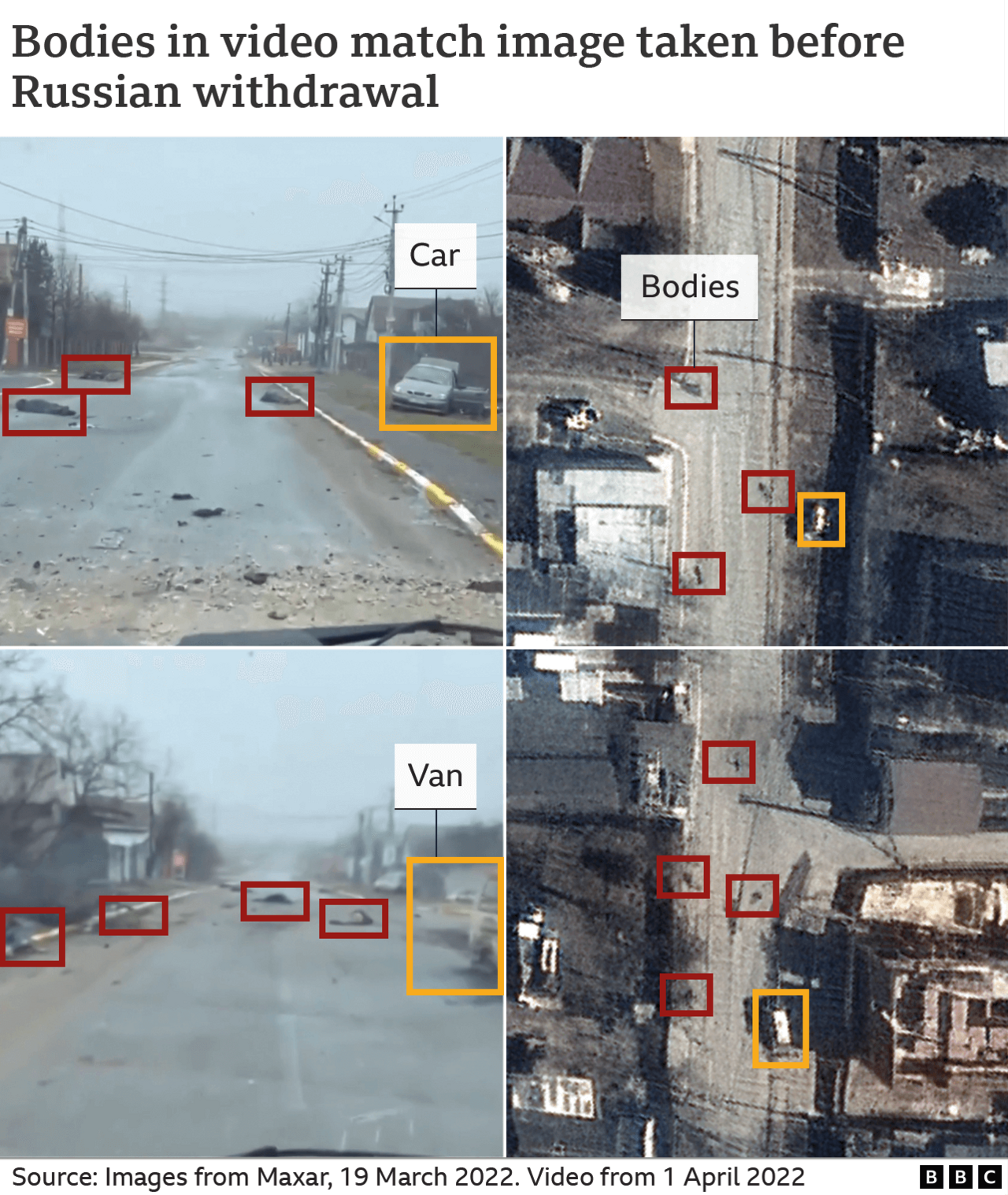
In both, there are bodies lying in the same parts of the road (marked in red) and near vehicles (marked in yellow).
Pro-Russian social media accounts also circulated a slowed-down version of the footage on the same road, external, claiming that the arm on one of the bodies moved.
The video is grainy but a closer analysis of it shows that what is claimed to be a moving arm, is actually a mark in the bottom right corner of the vehicle's windscreen.
Debunking Russian claims about Bucha killings
We've circled this mark - which looks like a raindrop or a speck of dirt - along with similar marks visible on the windscreen earlier in the video.
Another Russian claim focuses on a different part of the footage. The car passes another body, lying next to a pavement with red and yellow stones and shattered brown fencing.
As it drives on, the body can be seen briefly in the right-hand wing mirror. Pro-Russian accounts claim the body "sits up".
But a slowed-down version of the video shows the wing mirror is clearly distorting the reflection of the body, as well as houses in the background.
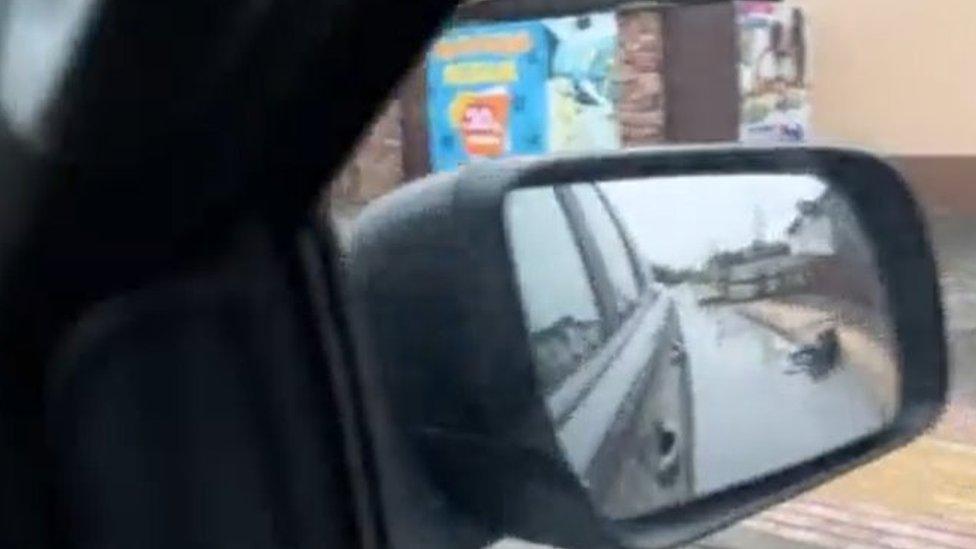
The body in question appears in the car's wing mirror during the video
The same effect can be seen in videos of similar wing mirrors posted on the internet, external.
The BBC has matched both bodies from the video (posted on 2 April) with high-resolution photos provided by Getty Images and AFP on 3 April.
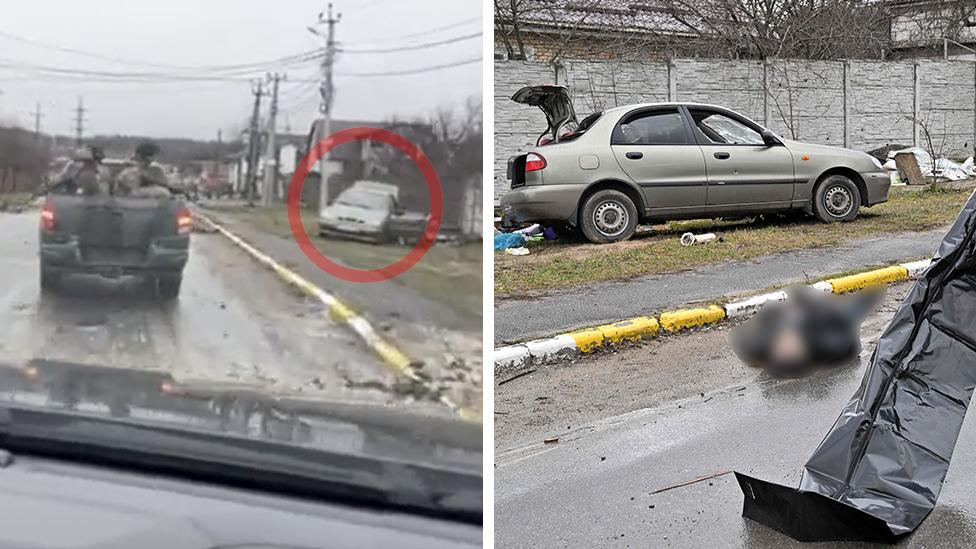
In the video, the first body is lying on their back near a white and yellow kerb. The pavement to the right is part asphalt and part grass. A silver car can be seen on the pavement with its boot open in front of a white fence.
The same car, kerb, pavement and fence are visible in the Getty/AFP image.
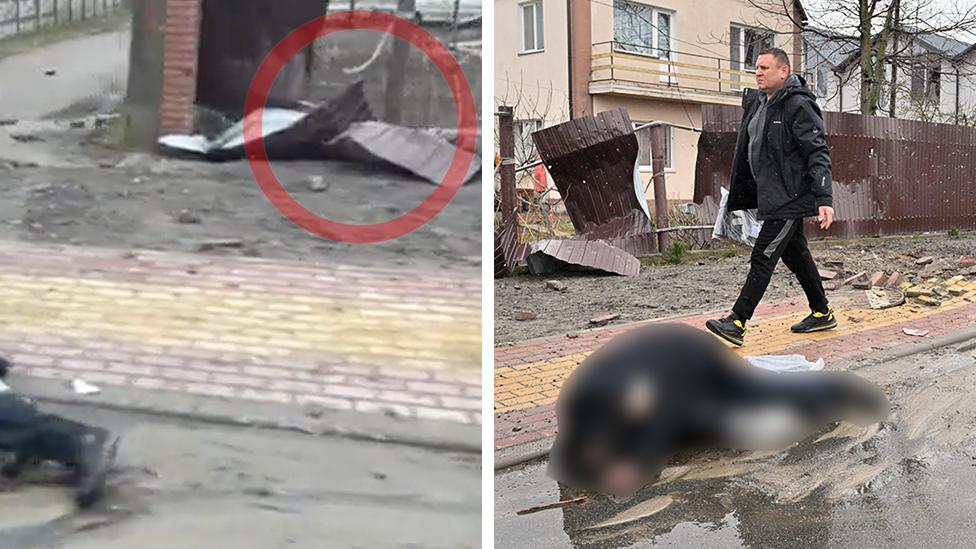
The second body has a black jacket and what appears to be a bloodied tourniquet or bandage on the right arm. They are lying on their side next to a red and yellow pavement, in front of a shattered brown fence.
The black jacket, tourniquet/bandage, pavement and fence all match the photo of the body published by Getty/AFP.
Claim: Satellite images were taken after Russians departed
A pro-Russian social media account, Rybar, says the Maxar satellite images shown in this article were not taken on 19 March - but on 1 April, the day after Russian forces departed.
Russia has made unfounded claims the killings were carried out by Ukrainians, but if the bodies were there on 19 March as the satellite images show, that cannot be the case. At that time Russia controlled the area.
Rybar says its conclusions are based on an analysis of shadows from images downloaded from the Maxar database, revealing the date and time at which the photograph was taken.
We contacted Maxar, who said it appeared Rybar had used the company's image search tools wrongly, and that if correctly used, the images can clearly be shown to be from 19 March.
The BBC has also checked this analysis, comparing images from three separate companies (PlanetLab, Apollo Mapping and Maxar) taken from the available satellite imagery over this period.
We've determined that the lengths of the shadows (and therefore the angle of the sun) is consistent with the satellite images having been taken on the morning of 19 March and not on 1 April.
Claim: Bodies 'not stiffened'
Russia's Ministry of Foreign Affairs tweeted: "It is of particular worry that all the bodies of the people whose images have been published by the Kiev regime are not stiffened after at least four days."
According to the Ukrainian military, the Russians left in the early hours of 31 March. The Russians say they left on 30 March.
In the hours after death, bodies go through a process called rigor mortis where muscles contract and stiffen.
We asked a forensic pathologist for their opinion on whether a body would be expected to be "stiffened" after four days. One who has worked in places including Kosovo and Rwanda on war crimes investigations, who did not want to be named, told the BBC that by four days rigor mortis has "usually subsided".
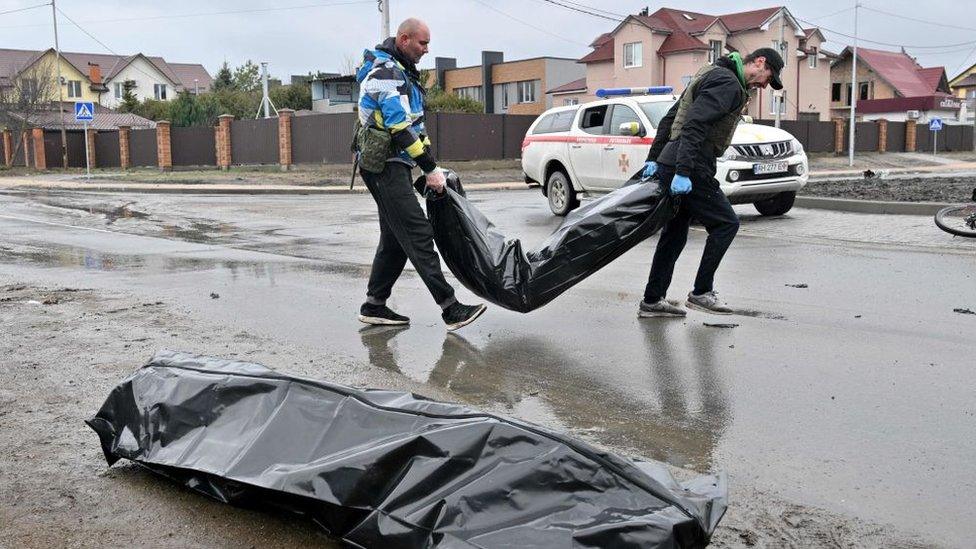
Workers have been putting the dead found in Bucha into body bags
The Russian tweet also claimed that the bodies "have no typical cadaver stains".
It's not clear what this means but the pathologist said the appearance of someone who has died from a gunshot wound or other act of violence will vary widely depending on the weapon used, from what distance they were shot and so on.
There isn't always a lot of visible blood as it may pool underneath people or soak into heavy clothing, especially if someone is dressed for cold weather. The tweet could be referring to the fact the blood within your body pools downwards after death as it stops circulating around the body, which can lead the skin to turn reddish or purple.
But if someone is lying down, the site of this blood pooling and discolouration may well not be visible from an image alone.
Claim: 'Not a single local resident has suffered from any violent action'
The Russian defence ministry claimed that while Bucha was under Russian control "not a single local resident has suffered from any violent action".
This claim, however, contradicts numerous eyewitness accounts from residents.
A local teacher told Human Rights Watch , externalon 4 March that Russian forces had rounded up five men and summarily executed one of them.
Local residents who spoke to the Russian investigative website The Insider painted a similar picture. "These were horrific days. When neither your courtyard, your house or even your life belongs to you. There is no electricity, water, gas. It's forbidden to leave the house, if you leave - you get shot," local resident Kristina told The Insider, external.
Locals told the BBC that the Russians had systematically broken down doors to loot flats, and, while soldiers stole valuables and food, residents were forced to sit in the cellar.
This report was originally published on 5 April and has since been updated.
Reporting by: Jake Horton, Shayan Sardarizadeh, Rachel Schraer, Olga Robinson, Alistair Coleman, Daniele Palumbo and Joshua Cheetham. Video production by: Sarah Glatte and Jacqueline Galvin.
